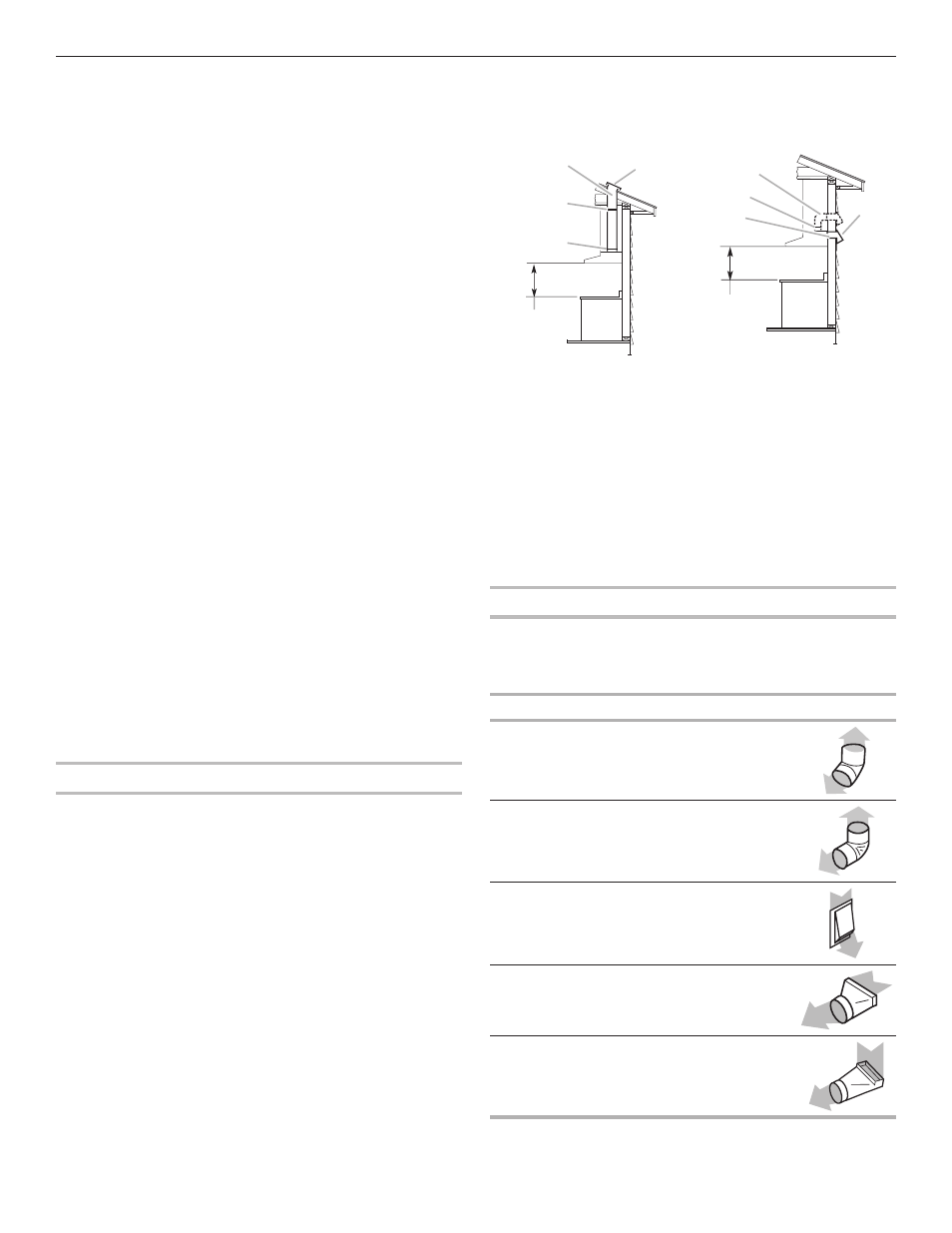Venting requirements, Vented models only) – Maytag UXT5536AAS Manuel d'utilisation
Page 5

5
Venting Requirements
(Vented Models Only)
■
Vent system must terminate to the outdoors,
except for non-vented (recirculating) installations.
■
Do not terminate the vent system in an attic or
other enclosed area.
■
Do not use a 4" (10.2 cm) laundry-type wall cap.
■
Use a 6" (15.2 cm) or larger round metal vent or a
3
1
/
4
" x 10" (8.3 x 25.4 cm) rectangular metal vent.
Rigid metal vent is recommended. Plastic or metal
foil vent is not recommended.
■
The length of vent system and number of elbows should
be kept to a minimum to provide efficient performance.
For the most efficient and quiet operation:
■
Use no more than three 90° elbows.
■
Make sure there is a minimum of 24" (61 cm) of straight
vent between the elbows if more than 1 elbow is used.
■
Do not install 2 elbows together.
■
Use clamps to seal all joints in the vent system.
■
The vent system must have a damper. If roof or wall cap has
a damper, do not use damper supplied with the range hood.
■
Use caulking to seal exterior wall or roof opening
around the cap.
Cold Weather Installations
An additional back draft damper should be installed to minimize
backward cold air flow and a thermal break should be installed
to minimize conduction of outside temperatures as part of the
vent system. The damper should be on the cold air side of the
thermal break.
The break should be as close as possible to where the vent
system enters the heated portion of the house.
Makeup Air
Local building codes may require the use of makeup
air systems when using ventilation systems greater than
specified CFM of air movement. The specified CFM varies
from locale to locale. Consult your HVAC professional for
specific requirements in your area.
Venting Methods
Vent system can terminate either through the roof or wall.
Use 3
1
/
4
" x 10" (8.3 x 25.4 cm) with a maximum vent length
of 35 ft (10.7 m) or 6" (15.2 cm) or larger round vent with a
maximum length of 50 ft (15.2 m) for vent system.
NOTE: Flexible vent is not recommended. Flexible vent
creates back pressure and air turbulence that gently reduces
performance.
Roof Venting
Wall Venting
A
B
D
C
E
A
B
C
D
E
A. 6" (15.2 cm) or larger round
vent or a 3
1
/
4
" x 10" (8.3 x
25.4 cm) rectangular vent
through roof
B. Round vent: use 6" (15.2 cm)
or larger round damper
(purchased separately)
C. Round vent: use 3
1
/
4
" x 10"
(8.3 x 25.4 cm) to 6" (15.2 cm)
or larger diameter transition
piece (purchased separately)
D. 24" to 30" (61 to 76.2 cm)
above electric cooking surface
27" to 30" (68.6 to 76.2 cm)
above gas cooking surface
E. Roof cap
A. 6" (15.2 cm) or larger round
vent or a 3
1
/
4
" x 10" (8.3 x
25.4 cm) rectangular vent
through the wall
B. Round vent: use 3
1
/
4
" x 10"
(8.3 x 25.4 cm) to 6" (15.2 cm)
or larger diameter transition
piece (purchased separately)
C. 3
1
/
4
" x 10" (8.3 x 25.4 cm)
through the wall
D. 24" to 30" (61 to 76.2 cm)
above electric cooking surface
27" to 30" (68.6 to 76.2 cm)
above gas cooking surface
E. Wall cap
Calculating Vent System Length
To calculate the length of the system you need, add the
equivalent feet (meters) for each vent piece used in the system.
6” (15.2 cm) or Larger Round Vent System
Vent Piece
Round
45° elbow
2.5 ft (0.8 m)
90° elbow
5 ft (1.5 m)
6" (15.2 cm) or larger wall cap
0 ft (0 m)
3
1
/
4
" x 10" (8.3 cm x 25.4 cm)
to 6" (15.2 cm) or larger
4.5 ft (1.4 m)
3
1
/
4
" x 10" (8.3 cm x 25.4 cm) to
6" (15.2 cm) or larger 90° elbow 5 ft (1.5 m)